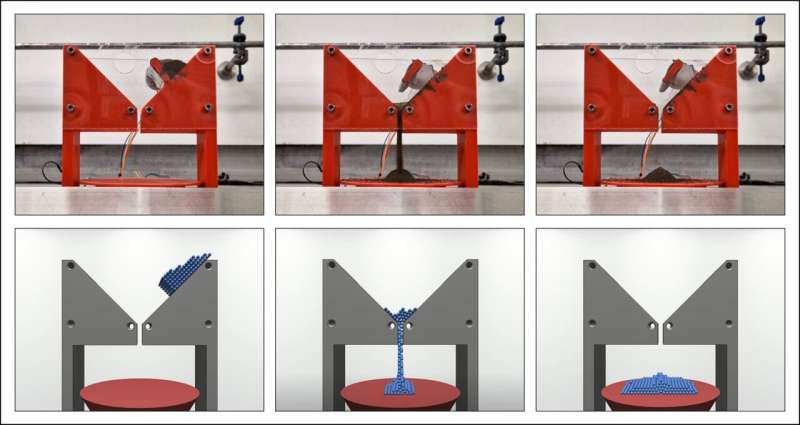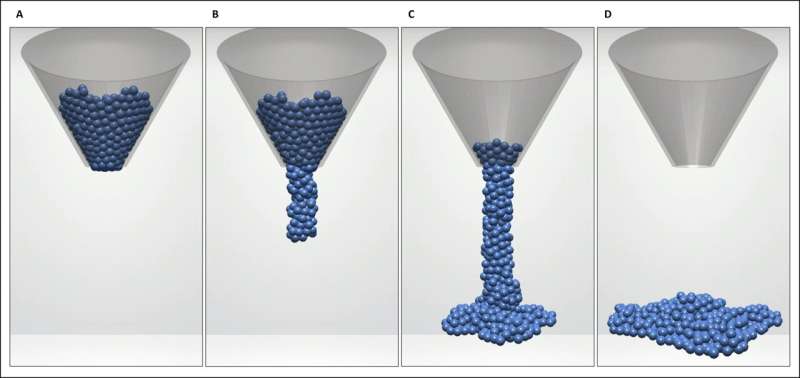This article has been reviewed according to Science X's editorial process and policies. Editors have highlighted the following attributes while ensuring the content's credibility:
fact-checked
trusted source
proofread
New realistic computer model will help robots collect moon dust

A new computer model mimics moon dust so well that it could lead to smoother and safer lunar robot teleoperations. The tool, developed by researchers at the University of Bristol and based at the Bristol Robotics Laboratory, could be used to train astronauts ahead of lunar missions.
Their research is published in the journal Frontiers in Space Technologies.
Working with their industry partner, Thales Alenia Space in the UK, which has specific interest in creating working robotic systems for space applications, the team investigated a virtual version of regolith, another name for moon dust.
Lunar regolith is of particular interest for the upcoming lunar exploration missions planned over the next decade. From it, scientists can potentially extract valuable resources such as oxygen, rocket fuel or construction materials, to support a long-term presence on the moon.
To collect regolith, remotely operated robots emerge as a practical choice due to their lower risks and costs compared to human spaceflight. However, operating robots over these large distances introduces large delays into the system, which make them more difficult to control.
Now that the team knows this simulation behaves similarly to reality, they can use it to mirror operating a robot on the moon. This approach allows operators to control the robot without delays, providing a smoother and more efficient experience.
Lead author Joe Louca, based in Bristol's School of Engineering Mathematics and Technology explained, "Think of it like a realistic video game set on the moon—we want to make sure the virtual version of moon dust behaves just like the actual thing, so that if we are using it to control a robot on the moon, then it will behave as we expect. This model is accurate, scalable, and lightweight, so can be used to support upcoming lunar exploration missions."
This study followed from previous work of the team, which found that expert robot operators want to train on their systems with gradually increasing risk and realism. That means starting in a simulation and building up to using physical mock-ups, before moving on to using the actual system. An accurate simulation model is crucial for training and developing the operator's trust in the system.
While some especially accurate models of moon dust had previously been developed, these are so detailed that they require a lot of computational time, making them too slow to control a robot smoothly. Researchers from DLR (German Aerospace Centre) tackled this challenge by developing a virtual model of regolith that considers its density, stickiness, and friction, as well as the moon's reduced gravity. Their model is of interest for the space industry as it is light on computational resources, and hence can be run in real-time. However, it works best with small quantities of moon dust.

The Bristol team's aims were to firstly extend the model so it can handle more regolith, while staying lightweight enough to run in real-time, and then to verify it experimentally.
Louca added, "Our primary focus throughout this project was on enhancing the user experience for operators of these systems—how could we make their job easier? We began with the original virtual regolith model developed by DLR, and modified it to make it more scalable. Then, we conducted a series of experiments—half in a simulated environment, half in the real world—to measure whether the virtual moon dust behaved the same as its real-world counterpart."
As this model of regolith is promising for being accurate, scalable and lightweight enough to be used in real-time, the team will next investigate whether it can be used when operating robots to collect regolith.
They also plan to investigate whether a similar system could be developed to simulate Martian soil, which could be of benefit for future exploration missions, or to train scientists to handle material from the highly anticipated Mars Sample Return mission.
More information: Joe Louca et al, Verification of a virtual lunar regolith simulant, Frontiers in Space Technologies (2024). DOI: 10.3389/frspt.2024.1303964
Provided by University of Bristol





















